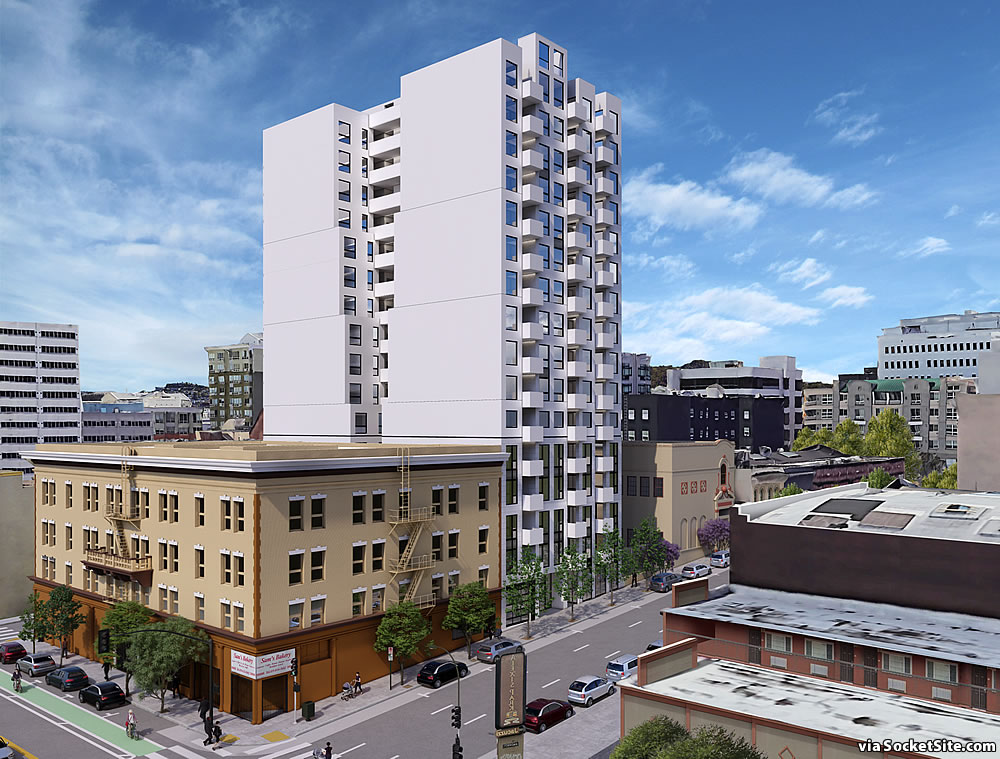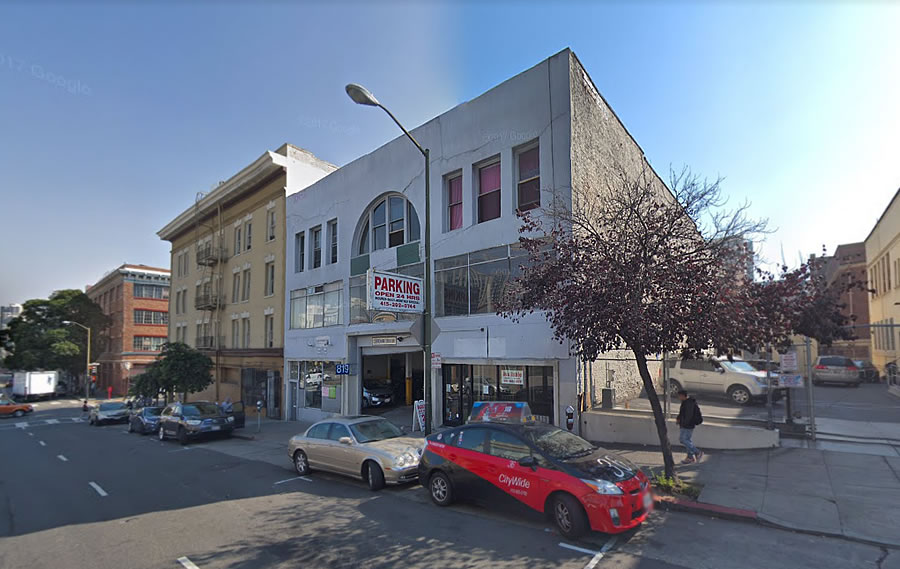Having failed to sell at auction and survived a foreclosure scare, plans to entitle a bigger-than-bonus-sized tower to rise on the former National Guard armory turned parking garage site at 819 Ellis Street are progressing.
While conceptual plans for a 13-story tower to rise up to 135 feet in height upon the Polk Gulch parcel were making the rounds a few years ago, a new set of plans for a 16-story, 165-foot-tall tower have not only been drawn by rg-architecture but a formal application to entitle the 16-story tower has been submitted to Planning, sponsored by JS Sullivan Development.
If approved and the ground is broken, the development as proposed would yield 120 condos, including 60 studios and 60 one-bedrooms, with a ground floor commercial space and off-street parking for 30 cars and 106 bikes, leveraging both a State Density Bonus and proposed “Cars to Casas” ordinance for the height, mass and density of the development as envisioned.
We’ll keep you posted and plugged-in.


since “cars to casas” is not yet approved by the Board and approval is certainly not certain, that’s jumping the gun a bit, no?
Getting your head out over the skis would be a better sports analogy. I think it’s going to get approved; it sailed through planning like a wingsail catamaran.
So did Mandleman’s 4plex ordinance, but the mayor will likely veto with weak approval at the Board (6-4), and the Board may be angry about that and retaliate with rejection of the mayor’s cars to casas proposal.
So when they do these car to casas ideas who is investing in the already overburdened transit systems and I’m not talking BRT van Mess but actual capacity building of transit for population increases? They seem pretty far behind on the 30×30 subway system solutions… SFMTA anyone?
SFMTA did get more money from the San Francisco General Fund than they thought they would for the immediate budget, but sure: if you are talking about increasing rail lines, there is no one really working toward meaningful capacity increases.
When you write “already overburdened transit systems”, you must be talking about the level it was at pre-pandemic because, as the tongue wagers in these comment threads will tell you, SFMTA’s ridership was severely impacted by the COVID-19 pandemic and subsequent exodus from San Francisco. According to SFMTA’s Budget Priorities for FY 2023 to FY 2024 (scroll down to the subheading Budget Background):
Emphasis added. Ever notice how when a new market-rate condo building is proposed with no parking the armchair planners in these comment threads cheer and just assume the newly-arrived residents will adopt a “car free lifestyle”, but never say anything about whether S.F.’s public transit has or will in the near term have the capacity to support all the newcomers the building will house?
It bears mentioning that had Proposition A passed, $10 million would have become available for improvements to the Muni train system, including the train communication and control systems, but upwards of $70 million would have been devoted to, in one way or another, continuing to prosecute the war on cars, by narrowing traffic lanes, protecting more bike and bus lanes and traffic slowing measures, etc. I think that imbalance had something to do with why it failed.
At the risk of sounding curmudgeonly …
It might help if SFMTA enforced fare requirements. I’ve had multiple people remark how few people even go through the motions of pretending to pay bus fares now – at least in the Richmond and Western Addition. You can’t collect what isn’t paid in the first place.
As for failure of Prop A … pure speculation but I wonder if it’s another facet of voter frustration with feel-good policies versus actual real-world benefits. Case in point – the City recently reduced the speed limit on Balboa, in the Inner Richmond, to 20 mph. Nominally this was to improve pedestrian safety, but – never mind that they were never ticketing people before for going over the former 25 mph limit, nor are the police ticketing the countless drivers running stop signs. (And I’m not talking about California stops; I’m talking outright roll-throughs … I would wager money that you can stand at any intersection between Arguello and Park Presidio, on Anza, Balboa, or Cabrillo, and within 5 minutes you will see a complete failure to stop.)
SFMTA fare cheats, failure to prosecute traffic violations, voter ire with the School Board and our former DA – I think it’s all part of a broader malaise and frustration with the failures of the system